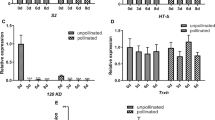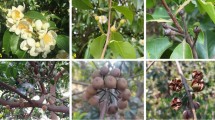Abstract
Expression of the S-RNase genes in the self-compatible (SC) apricot (Prunus armeniaca L.) cultivar Katy, the self-incompatible (SI) cultivar Xinshiji and their F1 seedling was examined in this study. Three S-genotypes, S9Sc (Sc, self-compatibility S-gene absent from the style), S8S9, and S8S10, were obtained. Seedlings with S-RNase that migrated as a single band in gel electrophoresis were SC, despite high transcript abundance, and those with S-RNase that migrated as two bands were SI with high transcript abundance or SC with low transcript expression. S8-RNase was induced in SI cultivars only 24 h after self-pollination, indicating post-transcriptional regulation of S8-RNase in SI apricots. A Proteomic study showed that 35 protein spots were synthesized differently between SC and SI pistils. Fifteen of the 35 protein spots were identified; nine proteins, including receptor protein kinase-like protein, reversibly glycosylated polypeptide-2, and isoflavone reductase-like protein, were detected only in the SC pistils; while nine proteins, including actin 7, a putative serine/threonine kinase, and S-RNase, were detected only in the SI pistils. A mitochondrial NAD-dependent malate dehydrogenase and a probable elongation factor G were up-regulated, while heat shock cognate 70 was down-regulated in the SC pistils compared to those in the SI pistils. The results suggest that the proteins responsible for self-compatibility and self-incompatibility may be different.






Similar content being viewed by others
Abbreviations
- ACN:
-
Acetonitrile
- BB:
-
Bromophenol blue
- BS:
-
At balloon stage
- DTT:
-
Dithiothreitol
- FQRT-PCR:
-
Fluorescence quantification RT-PCR technology
- HPLC:
-
High-pressure liquid chromatography
- IAM:
-
Iodoacetamide
- IEF:
-
Isoelectric focusing electrophoresis
- LC-ESI-MS/MS:
-
Liquid chromatography-electrospray ion trap tandem mass spectrometry
- MS:
-
Mass spectrometer
- PMSF:
-
Phenylmethyl sulfonyl fluoride
- RT-PCR:
-
Reverse transcript-PCR
- SI:
-
Self-incompatible
- SC:
-
Self-compatible
- TFA:
-
Triflouroacetic acid
- 2-DE:
-
Two-dimensional gel electrophoresis
References
Wang Y, Wang X, Skirpan AL, Kao T-H (2003) S-RNase-mediated self-incompatibility. J Exp Bot 54:115–122
Sijacic P, Wang X, Skirpan AL, Wang Y, Dowd PE, McCubbin AG, Huang S, Kao T-H (2004) Identification of the pollen determinant of S-RNase-mediated self-incompatibility. Nature 429:302–305
McClure B (2004) S-RNase and SLF determine S-haplotype-specific pollen recognition and rejection. Plant Cell 16:2840–2847
Qiao H, Wang F, Zhao L, Zhou J, Lai Z, Zhang Y, Robbins TP, Xue Y (2004) The F-box protein AhSLF-S2 controls the pollen function of S-RNase-based self-incompatibility. Plant Cell 16:2307–2322
Romero C, Vilanova S, Burgos L, Martinez-Calvo J, Vicente M, Llacer G, Badenes ML (2004) Analysis of the S-locus structure in Prunus armeniaca L. Identification of S-haplotype specific S-RNase and F-box genes. Plant Mol Biol 56:145–157
Certal AC, Almeida RB, Boskovic R, Oliveira MM, Feijó JA (2002) Structural and molecular analysis of self-incompatibility in almond (Prunus dulcis). Sex Plant Reprod 15:13–20
Wunsch A, Hormaz JI (2004) Cloning and characterization of genomic DNA sequences of four self-incompatibility alleles in sweet cherry (Prunus avium L.). Theor Appl Genet 108:299–305
Zisovich HA, Stern AR, Sapir G, Shafir S, Goldway M (2004) The RHV region of S-RNase in the European pear (Pyrus communis) is not required for the determination of specific pollen rejection. Sex Plant Reprod 17:151–156
Broothaerts W (2003) New findings in apple S-genotype analysis resolve previous confusion and request the re-numbering of some S-alleles. Theor Appl Genet 106:703–714
Entani T, Iwano M, Shiba H, Che FS, Isogai A, Takyama S (2003) Comparative analysis of the self-incompatibility (S-) locus region of Prunus mume: identification of a pollen-expressed F-box gene with allelic diversity. Genes Cells 8:203–213
Kao T-H, Tsukamoto T (2004) The molecular and gentic bases of S-RNase-based self-incompatibility. Plant Cell 16:72–83
Albuquerque N, Egea J, Pérez-Tornero O, Burgos L (2002) Genotyping apricot cultivars for self-(in) compatibility by means of RNases associated with S-alleles. Plant Breed 121:343–347
Halász J, Hegedûs A, Hermán R, Stefanovits-Bányai E, Pedryc A (2005) New self-incompatibility alleles in apricot (Prunus armeniaca L.) revealed by stylar ribonuclease assay and S-PCR analysis. Euphytica 145:57–66
Qi J, Gu MR, Shu HR (2003) Cloning and expression of self-incompatibility related S-RNase gene in apricot. J Agric Biotechnol 11:148–153 (in Chinese with English abstract)
Chen XS, Gao DS, Li XL, Zhang YM, Zhang LZ (2001) ‘Xinshiji’–a new early ripening apricot variety obtained by embryo culture. Acta Hortic Sin 28:475 (in Chinese with English abstract)
Wu Y, Chen XS, Feng JR, Chen XL (2005) Inheritance of S-gene among the F1 progenies in apricot. Acta Hortic Sin 32:397–402 (in Chinese with English abstract)
Silva NF, Goring DR (2001) Review: mechanisms of self-incompatibility in flowering plants. Cell Mol Life Sci 58:1988–2007
Xue MN, Yang JH (2000) Two-dimensional electrophoresis of self-and cross-pollinated stylar proteins of Shatianyou (Citrus grandis osbeck cv.). J Guangxi Normal University 18:83–85 (in Chinese with English abstract)
Miljus-Dukic J, Ninkovic S, Radovic S, Maksimovic V, Brkljiacic J, Neskovic M (2004) Detection of proteins possibly involved in self-incompatibility response in distylous buckwheat. Biol Plant 48:293–296
Furuyama T, Dzelzkalns VA (1999) A novel calcium-binding protein is expressed in brassica pistils and anthers late in flower development. Plant Mol Biol 39:729–737
Murase K, Shiba H, Iwano M, Che FS, Watanabe M, Isogai A, Takayama S (2004) A Membrane-anchored protein kinase involved in Brassica self-Incompatibility signaling. Science 303:1516–1519
Foster E, Levesque-Lemay M, Schneiderman D, Albani D, Schernthaner J, Routly E, Robert LS (2005) Characterization of a gene highly expressed in the Brassica napus pistil that encodes a novel proline-rich protein. Sex Plant Reprod 17:261–267
Schultz CJ, Hauser K, Lind JL, Atkinson AH, Pu ZY, Aderson MA, Clarke AE (1997) Molecular characterization of a cDNA sequence encoding the backbone of a style-specific 120 kDa glycoprotein which has features of both extensions and arabinogalactan proteins. Plant Mol Biol 35:833–845
Hancock CN, Kent L, McClure B (2005) The 120 kDa glycoprotein is required for S-specific pollen rejection in Nicotiana. Plant J 43:716–723
McClure B, Mou B, Canevascini S, Bernatzky R (1999) A small asparagines-rich protein required for S-allele-specific pollen rejection in Nicotiana. Proc Natl Acad Sci USA 96:13548–13553
O’Brien M, Bertrand C, Mattoon DP (2002) Characterization of a fertilization-induced and developmentally regulated plasma-membrane aquaporin expressed in reproductive tissues, in the wild potato Solanum chacoense Bitt. Planta 215:485–493
Kuboyama T (1998) A novel thaumatin-like protein gene of tobacco is specifically expressed in the transmitting tissue of stigma and style. Sex Plant Reprod 11:251–256
van Eldik GJ, Ruiter RK, Colla PHWN, van Herpen MMA, Schrauwen JAM, Wullems GJ (1997) Expression of an isoflavone reductase-like gene enhanced by pollen tube growth in pistils of Solanum tuberosum. Plant Mol Biol 33:923–929
Sassa H, Hirano H (1998) Style-specific and developmentally regulated accumulation of a glycosylated thaumatin/PR5-like protein in Japanese pear (Pyrus serotina Rehd.). Planta 205:514–552
de Graaf BHJ, Knuiman BA, Van Der Weerden GM, Ferom R, Derksen J, Mariani C (2004) The PELPIII glycoprotein’s in Solanaceae: stylar expression and transfer into pollen tube walls. Sex Plant Reprod 16:245–252
Feng JR, Chen XS, Wu Y, Liu W, Liang Q, Zhang LJ (2006) Detection and transcript expression of S-RNase gene associated with self-incompatibility in apricot (Prunus armeniaca L.). Mol Biol Rep 33:215–221
Chen XS, Wang ZG, Zhou RY (1989) Studies on the emasculation method for fruit cross. J Shandong Agric Univ 20:21–26 (in Chinese with English abstract)
Tamura M, Ushijima K, Sassa H, Hirano H, Tao R, Gradziel TM, Dandekar AM (2000) Identification of self-incompatibility genotypes of almond by allele-specific PCR analysis. Theor Appl Genet 101:344–349
Furuyama T, Dzelzkalns VA (1999) A novel calcium-binding protein is expressed in brassica pistils and anthers late in flower development. Plant Mol Biol 39:729–737
Boskovic R, Tobutt KR, Duval H, Batlle I (1999) A stylar ribonuclease assay to detect self-compatible seedlings in almond progenies. Theor Appl Genet 99:800–810
Hiratsuka S, Zhang SL, Nakagawa E, Kawai Y (2001) Selective inhibition of the growth of incompatible pollen tubes by S-protein in the Japanese pear. Sex Plant Reprod 13:209–221
Tobutt KR, Boskovic R, Cerovic R, Sonneveld T (2004) Identification of incompatibility alleles in the tetraploid species sour cherry. Theor Appl Genet 108:775–785
Hiratsuka S, Nakashima M, Kamasaki K, Kubo T, Kawai Y (1999) Comparison of an S-protein expression between self-compatible and -incompatible Japanese pear cultivars. Sex Plant Reprod 12:88–93
Lers A, Burd S, Lomaniec E, Droby S, Chalutz E (1998) The expression of a grapefruit gene encoding an isoflavone reductase-like protein is induced in response to UV irradiation. Plant Mol Biol 36:847–856
Goring DR, Walker JC (2004) Self-rejection—a new kinase connection. Science 303:1474–1475
Staiger CJ, Franklin-tong VE (2003) The actin cytoskeleton is a target of the self-incompatibility response in Papaver rhoeas. J Exp Bot 54:103–113
Geitmann A, McConnaughey W, Lang-Pauluzzi I, Franklin-Tong VE, Emons AMC (2004) Cytomechanical properties of Papaver pollen tubes are altered after self-incompatibility challenge. Biophys J 86:3314–3323
Acknowledgements
The research was supported by the National Natural Science Foundation (No. 30370992 and 30760143), the Special Program for Doctorial Site of Universities (No. 200404344011) and the Key Project for Excellent College Teachers from Ministry of Education, China (No. 204178), which are gratefully acknowledged. The authors sincerely thank Dr. Guanggan Hu in Michael Smith Laboratories, the University of British Columbia, Canada for his carefully reading of this manuscript.
Author information
Authors and Affiliations
Corresponding author
Rights and permissions
About this article
Cite this article
Feng, J.R., Chen, X.S., Yuan, Z.H. et al. Primary molecular features of self-incompatible and self-compatible F1 seedling from apricot (Prunus armeniaca L.) Katy × Xinshiji. Mol Biol Rep 36, 263–272 (2009). https://doi.org/10.1007/s11033-007-9175-2
Received:
Accepted:
Published:
Issue Date:
DOI: https://doi.org/10.1007/s11033-007-9175-2




